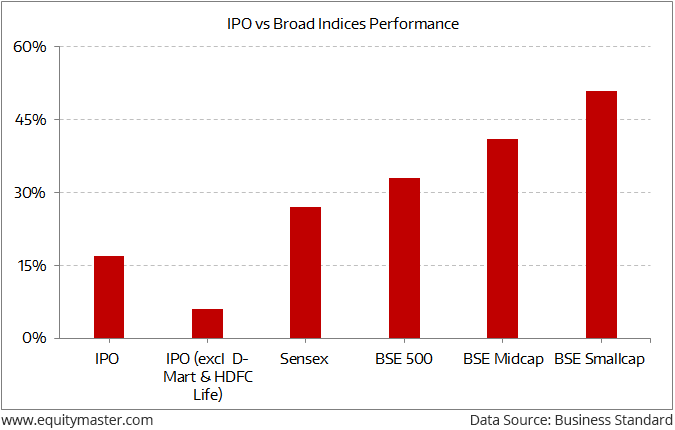Asian stock markets are lower today as Japanese and Hong Kong shares fall. The Nikkei 225 is off 0.5% while the Hang Seng is down 0.2%. The Shanghai Composite is trading down by 0.3%. US stocks rebounded on Tuesday, boosted by gains in industrial shares following reports of renewed trade negotiations between the United States and China.
Back home, India share markets have opened the day marginally higher. The BSE Sensex is trading up by 56 points while the NSE Nifty is trading up by 24 points. The BSE Mid Cap index opened and BSE Small Cap index opened the day up by 0.3% & 0.1% respectively.
Irrespective of the market sentiment, the BSE Sensex is scaling new highs. But look around you.
How many investors do you still see getting richer every day? Fewer than what you saw at the start of the year? Very few?
Well, the Sensex has gained Rs 60 trillion in market cap since 2004. That's a huge number. Nearly a third of the country's GDP. But how many investors have really benefitted from this rally? Very very few.
Mainly because most never joined. Even today less than 20% of Indian households invest directly or indirectly in stocks.
Also, because most of those who joined burnt their fingers with bad quality stocks. So, every time there was a sharp correction, these investors were the worst affected.
In the three big crashes since 2004, the Sensex lost about 31 trillion of market cap. And most of the investors who were scarred never bothered returning.
Sensex Gained Rs 60 Trillion and Lost Rs 31 Trillion of Market Cap Since 2004
Moving on... the rupee is currently trading at 68.61 to the US$.
Barring power stocks, all sectoral indices have opened the in green with energy stocks and PSU stocks witnessing maximum buying interest.
In the news from the automobile sector. In the latest development, Tata Motors Ltd reported its first quarterly loss in nearly three years on Tuesday, as its UK subsidiary Jaguar Land Rover sold fewer of its luxury cars to dealerships in China, while raw material costs rose.
The automaker said its first-quarter net loss was Rs 18.6 billion, compared with a profit of Rs 31.8 billion a year earlier that included a Rs 36.1 billion gain from changes to the way JLR's pension payments are calculated.
Reportedly, dealers in China delayed purchases to benefit from an import duty cut that came into effect after the end of the reporting quarter, and the planned dealer stock reduction in other markets also weighed on its business. That resulted in a 6.7% drop in quarterly revenue for JLR.
Total consolidated revenue from operations, however, rose to Rs 670.8 billion as compared with Rs 598.2 billion in the year ago period.
Total expenses during April-June rose about 17% to Rs 698.9 billion.
On a standalone basis, Tata Motors reported a net profit of Rs 11.9 billion. It had reported a net loss of Rs 4.6 billion in the first quarter last fiscal. Standalone total revenue from operations grew to Rs 168 billion during the quarter compared to Rs 103.7 billion in the same period of 2017-18.
Standalone volume rose 59% to 1,76,868 units driven by robust sales of commercial and passenger vehicles in the Indian market.
Tata Motors' share price opened the day down by 4.3%.
In another development. As per the data released by the commerce and industry ministry, growth of eight core sectors expanded to 7-month high of 6.7% in June due to better performance by cement, refinery and coal segments.
The eight sectors, which also include fertilisers, steel, natural gas, electricity and crude oil, had expanded by 1% in June last year.
The previous high rate of growth was recorded in November 2017 at 6.9%.
The growth rate in May was 4.3%.
Reportedly, the expansion in cement, refinery products and coal was 13.2%, 12% and 11.5% respectively, year-on-year basis.
Crude oil and natural gas registered a negative growth of 3.4% and 2.7% respectively in June compared to the year-ago period.
The expansion in the electricity generation was 4% in June compared to 2.2% in the same month of the last fiscal.
Steel sector, however witnessed a slower growth of 4.4% compared to 6% in June 2017.
The data revealed that expansion rate in the fertiliser segment was 1%, better than negative growth recorded in the year ago month.
During the April-June quarter of the current fiscal, the eight core industries recorded a growth of 5.2% as against 2.5% in the same period last year.
These eight core industries comprise 40.3% of the weight of items included in the Index of Industrial Production (IIP).
To get more updates on share market, click here.
This article was originally published in English at www.equitymaster.com
Read the complete Indian stock market update. For the terms of use, go here.


